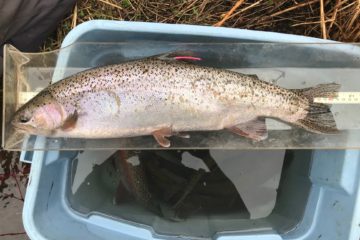A Guest Blog by Jon Hanson, Fish Biologist, NorthWestern Energy
An impressive migration was documented again this week by Patrick Uthe and Craig Podner (FWP Missoula). We had a 21 inch rainbow trout (3.5 lbs) that was captured in the Thompson Falls Fish Ladder March 25, 2020 and tagged with a Floy and PIT tag. It was released upstream, and then FWP recaptured it up Johnson Creek, a tributary to the lower Blackfoot River on April 27th, 2020. This is the furthest documented fish movement to date and the first documented connection from the Lower Clark Fork to the Blackfoot River system. In 33 days this rainbow moved upstream 150+ miles to where it likely hatched, to carry out its life history and presumably spawn.
When one collectively thinks about the independent restoration actions it took to have a positive cumulative effect it’s pretty remarkable. Starting in Johnson Creek where habitat conditions must be suitable enough for fish to spawn, survive the critical first couple of years, and then facilitate upstream return of adults, partners completed work that included; 3 culvert removals and installation of a bridge allowing for upstream fish passage, road decommissioning which improved habitat and reduced the risk of fine sediment delivery, and a three way protective land acquisition with Plum Creek, The Nature Conservancy, and Lolo National Forest. Several years ago this juvenile rainbow trout (now known as tag #0068) left Johnson Creek and moved downstream, the removal of Milltown Dam reduced a predatory population of nonnative northern pike from the reservoir. As this juvenile matured and instincts kicked in to return to its natal stream, the operation of the Thompson Falls fish ladder then started the upstream sequence and allowed access to the middle Clark Fork River. Again, the removal of Milltown Dam, allowed #0068 further access this Blackfoot River tributary, where it was trapped incidentally via another fisheries research project.
This success story supplements a similar migration by a rainbow trout to Rattlesnake Creek (in Missoula) via Thompson Falls Dam last spring.
These partnership efforts restore this possibility. The biological documentation linking all the actions is a notable feat. Montana Fish, Wildlife & Parks, Lolo National Forest, US Fish Wildlife Service, Big Blackfoot Chapter of TU, Trout Unlimited, The Nature Conservancy, and NorthWestern Energy are just a few of the key contributors to make this multi drainage success happen. Thank you to all the people who have been a part of these efforts up until now, and all those working towards a brighter future.
